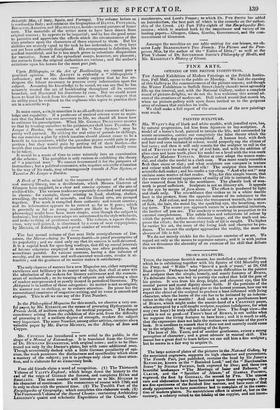PAINTED SCULPTURE.
MR. 1VveTT's dog of black and white marble, with jewelled eyes, has, by natural progression, led him from bijouterie to toy-sculpture. A model of a horse's head, painted to imitate the life, and surrounded by scenic accessories, carries out completely the false theory which the coloured marble dog partially exemplified. A human bust, with flesh and hair and eyes imitated in colour, would properly cap the climax of bad taste; and then it will only remain for the sculptor to call in the aid of TRUEFITT to make a wig of real hair, and with the addition of glass eyes and bone teeth, place his model on a level with the wax-work figures of Madame TUSSAUD. Better at once adopt the waxen mate. rial, and clothe the model in a cloth coat. Wax more nearly resembles flesh than stone or clay ; and what sculpture can compare in texture and colour with broad-cloth and silk ? The sculptor then becomes a scientific doll.maker ; and his studio a toy-shop. "And why not ?" may exclaim some matter. of-fact reader. Why, for this simple reason, that the nearer the external appearance of reality of life is imitated, the fur- ther removed from life is the semblance. The ghastly look of wax- work is proof sufficient. Sculpture is not an illusory art. It appeals to the eye by means of form alone. The effect is produced by light and shade only. The resemblance that strikes us in a white marble bust is the greater, from the opposite nature of its substance to the reality. Add colour, and you miss the transparent warmth, the texture of flesh, the hair, the moist lip, the sparkling eye, the breathing, mov- ing form. The nearer you approach nature in a substantial imitation, the further off you are. The mockery is revolting in proportion to its external completeness. The subtle hues and reflections of colour by which the painter refines the visionary image, aid the truth and im- prove the effect ; for the momentary look of iffe is caught. The higher he carries his art, the more of the living look and character he pro- duces. The nearer the sculptor approaches the reality, the more the absence of life is felt.
We do not merely stickle for the legitimate exercise of an art. We regard art only as the means to represent nature; and it is with justice that we denounce the absurdity of an exercise of its skill that defeats its own aim.























 Previous page
Previous page